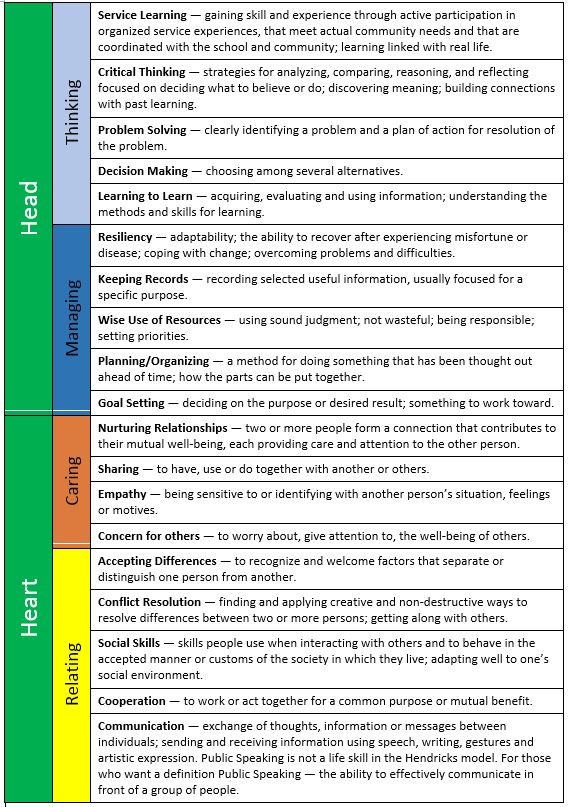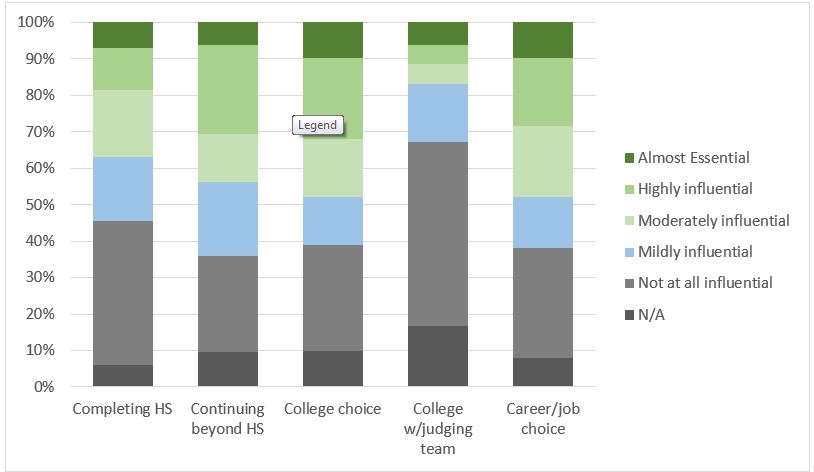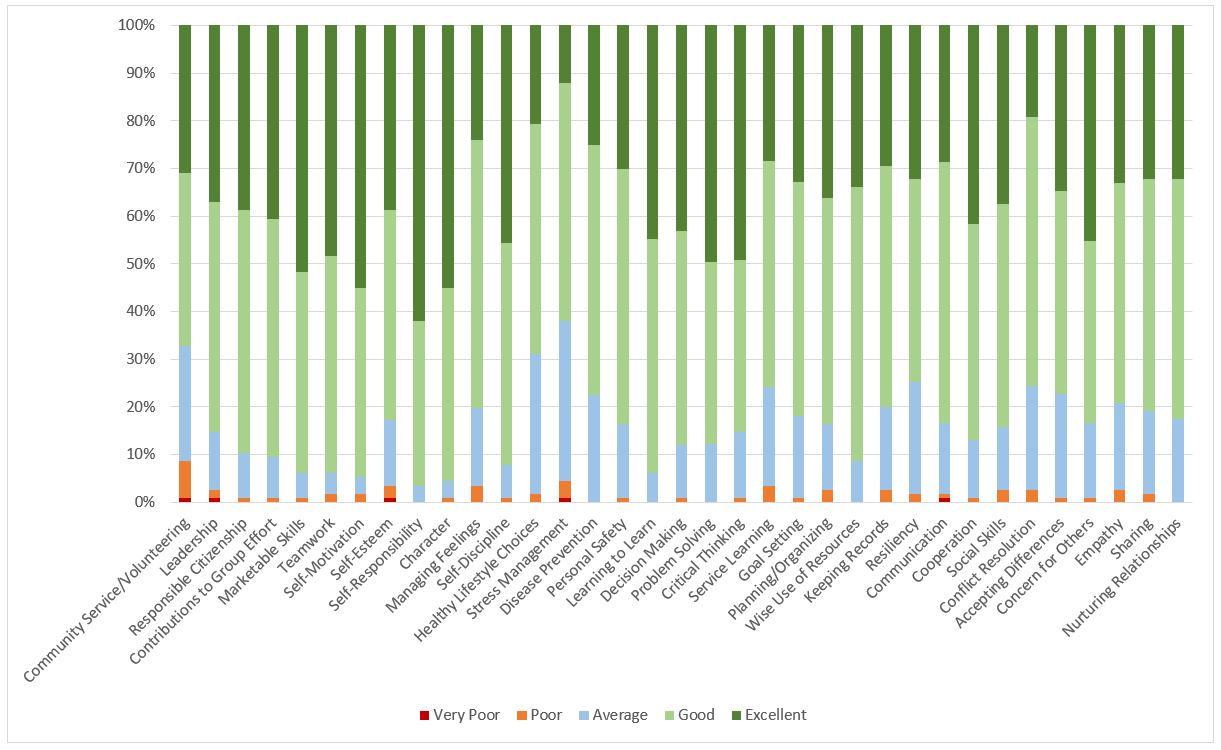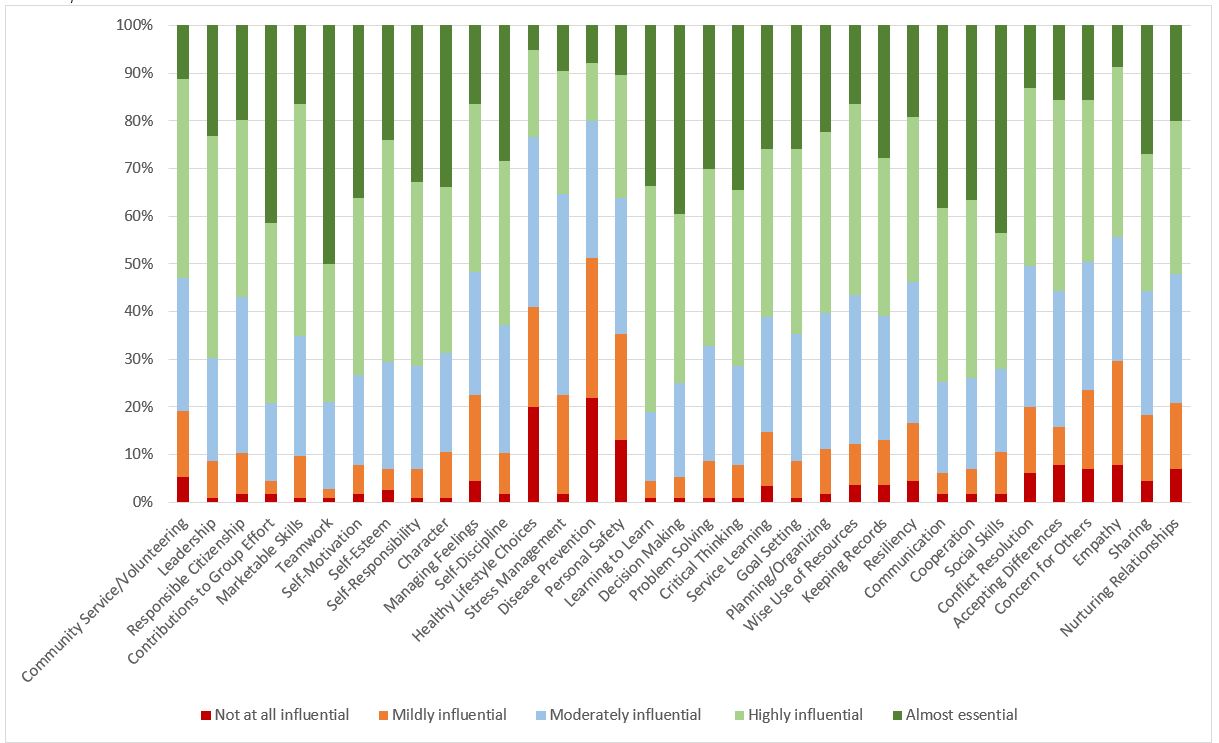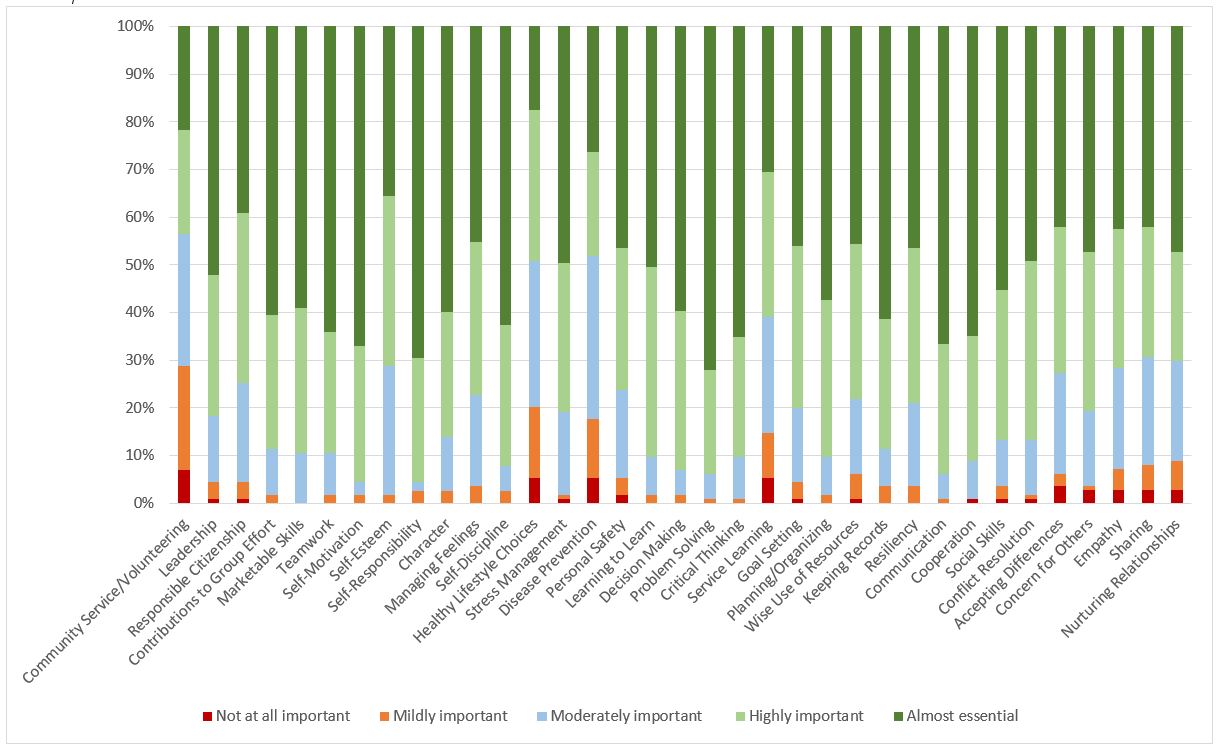Journal of the NACAA
ISSN 2158-9429
Volume 8, Issue 2 - December, 2015
The Impact of 4-H Judging Team Participation on Career and Life Skills
- Boone, D. A., Professor, West Virginia University
Anderson, E. H., Agricultural Extension Agent, Walton County, University of Florida IFAS Extension
Boone, H. N., Professor, West Virginia University
Woloshuk, J. M., Extension Specialist, Emeriti, West Virginia University
ABSTRACT
The purpose of the study was to determine whether participation in WV 4-H agricultural judging teams impacted life skills development. This study sought to measure the current life skill abilities of past 4-H state judging team winners from 1995 to 2006, determine their perception of the influence involvement on a judging team had on that ability, and compare that with the importance of the various life skills in participants' current jobs. 4-H judging team participation was found to influence education and career decisions and positively affect development of life skills, including many of those that respondents listed as being highly important in their current jobs. Problem solving, self-motivation, and self-responsibility were seen as having the highest importance in jobs; while 4-H judging teams also helped develop skills in learning to learn, teamwork, and decision making.
Introduction
One of 4-H’s primary goals is programming for positive youth development, therefore, it is designed to give youth the opportunity to improve life skills. This ultimately is intended to better prepare individuals for further education and eventually entering the workforce. Many of the life skills developed as a result of involvement with 4-H programs are relevant to a broad range of careers, not only those directly related to agriculture. Gaining and improving skills such as leadership, communication, critical thinking, problem solving, self-responsibility, cooperation, and teamwork can serve to give an individual a strong foundation for further growth and development.
Judging teams are a part of the 4-H curriculum that helps to build life skills. Arising as part of the early 4-H club work, judging teams were noted to have begun prior to 1921 (True, 1928). In West Virginia, participants may compete on eight different judging teams: home-site evaluation, livestock, poultry, dairy cattle, forestry, horse, land, and horticulture judging. While these categories focus on different agricultural aspects, the steps used in evaluation are all very similar. Participants develop a variety of life skills while studying for and participating as members of judging teams.
4-H agricultural judging teams are intended to provide a safe, positive environment for individuals to learn and develop life skills. Judging teams emphasize experiential activities, develop organizational skills, allowi youth to take part in leadership activities, and provide opportunities for volunteers to act as mentors to youths (WVU Extension, n.d.).
While the costs of offering judging programs may seem high, justification for their continuance may be found, in part, in the opportunities for development of life skills offered to participants. The life skills learned carry over to future education and occupational performance. Furthermore, the existence of judging teams at a collegiate level may influence potential students in deciding whether or not to attend a particular school (McCann & McCann, 1992).
There seems to be no question that 4-H and its associated educational programming develop life skills in youth. Judging teams, animal and livestock projects, camps, and 4-H in general have all been the focus of studies that have shown that youth participants develop a variety of skills. Leadership, communication, self-confidence, responsibility, and decision-making are just a few of those that are taken away by 4-H members. What is much less prevalent among the body of research on these topics is a connection to the jobs these youths go on to later in life. A study by Robinson (2006) looked at employability skills of graduates from a school of Agriculture, Food, and Natural Resources, but more research is needed in this area. How helpful do past participants in 4-H judging teams find the life skills they developed throguh 4-H to be useful in their current jobs?
Purpose
The purpose of this study was to determine how participation in West Virginia 4-H agricultural judging teams impacts life skills development. This study sought to determine the current life skill abilities of past 4-H state judging team winners from 1995 to 2006, determine how they perceive the abilities were influenced by involvement on a judging team, and compare the involvement with the importance of the various life skills in former participants' current jobs.
Objectives
- To describe how participating as a part of a West Virginia 4-H state agricultural judging team impacted the development of life skills.
- To describe how past West Virginia state 4-H judging team participants perceived their current level of life skill development.
- To determine past West Virginia state 4-H judging teams members’ perceived importance of various life skills to their current job.
- To describe how the life skills model used in 4-H programming related to skills needed in employment situations.
Research Design
A descriptive mailed survey was utilized to collect data from the target population. This allowed the collection of a wide scope of information as descriptive research asks questions about the nature, incidence, or distribution of variables. Rather than manipulating variables, it involves only describing them (Ary, Jacobs, & Sorenson, 2010). The design of this study was quantitative and included several open-ended questions. The study sought to determine information related to the factors which influenced participation in judging teams, life skill development associated with involvement on judging teams and how beneficial those skills are in their current field of employment. The questionnaire was developed using an instrument from a previous faculty study and was modified to include life skills as defined by Hendricks (1996). It also included the importance of the skills to their current job. A pilot study was conducted with undergraduate students who had 4-H judging experience, but were not a part of the study population. Minor adjustments for clarity were made to the survey based on feedback during the pilot study.
Population
The target population for this study was West Virginia state 4-H agricultural judging team contest winners from 1995 to 2006 who competed at the state level and went on to compete at the national level. A census was conducted of all these individuals. A list of past participants was provided by the State 4-H Youth Livestock Agriculture specialist and a request was made to the county extension agents in the individuals’ home county to seek assistance in providing current and up-to-date addresses. Of the original list of 320 winners, 33 were found to be undeliverable. A total of 117 surveys were returned from the remaining 287, one of which was unusable, for a response rate of 40.0%.
An independent t-test was used to compare the responses of early and late respondents to the number of years they participated in 4-H, their current age, and whether their current jobs were directly related to agriculture. No significant differences were found, therefore, generalizations were made to the target population.
Using the Targeting Life Skills Model by Hendricks (1996), each of the 35 skills were listed and accompanied by a definition of the skill (see Figure 1). Respondents were asked to rate their current level of ability in each of the 35 life skills, the level to which they perceived participation in a 4-H judging team had contributed to the development of that ability, and the importance of that life skill in their current jobs. Responses were given using a Likert type scale where 1 = not at all influential, 2 = mildly influential, 3 = moderately influential, 4 = highly influential, and 5 = almost essential.
Figure 1. Targeting Life Skills Definitions from Model by Hendricks (1996).
Findings
Demographics
Almost half of the respondents to this survey (48.3%) fell between the ages of 26 and 30. Respondents were much more likely to have a Bachelor’s or Master’s degree than any other level of education, with 35.1% having a Bachelor’s and 26.3% having a Master’s. Two thirds of those who participated in the study worked at agriculturally related jobs or careers and the majority wanted to stay in their current positions for the rest of their careers.
The average respondent participated in 4-H for 10 years. At the local level, judging team participation ranged from an average of 1.4 years on forestry judging teams to an average of 5.3 years on livestock judging teams. Time spent participating on state judging teams was similar to that at the local level ranging from an average of 1.3 years of participation for forestry judging teams to 5.2 years on poultry judging teams. The majority of participants spent only one year competing at the national level, and none spent more than two. Those on horticulture judging teams were the most likely to compete twice at the national level making the average length of participation 1.3 years.
Judging Team Practices and Experiences
Survey participants were influenced by a number of different people in their decision to join 4-H. The most influential in this decision were parents who were indicated as almost essential or as highly influential by 36.0% of respondents. Other 4-H members were likely to be highly influential (45.5%), while teachers were mostly not at all influential (58.1%) or only mildly influential (20.0%).
Extension agents were the individuals most chosen as being almost essential or highly influential in the decision to join 4-H judging teams (63.0%). Parents and 4-H leaders were also influential, with parents listed as almost essential or highly influential by 57.2% of the individuals and 4-H leaders listed as almost essential or highly influential by 52.9%. Teachers (54.8%) and siblings (48.1%) were most likely to be noted as not at all influential.
When asked to identify those who taught respondents the skills needed to compete on 4-H judging teams, the most popular choices were extension agents, parents or guardians, and other 4-H members. Extension agents were indicated by 62.1% of respondents, parents or guardians were reported by 54.3%, and other 4-H members reported by 52.6% of the respondents.
Those who participated in the study were asked to rate their experiences on a number of paired adjective continuums. Respondents were more likely to find their experiences wonderful rather than terrifying, exciting rather than boring, and a learning experience rather than a waste of time. They were also more likely to find their experiences relaxing rather than stressful but to a lesser degree than the other pairs.
The majority (88.2%) of respondents practiced at least once a week before their state judging contest, practicing from once a week to daily. Practice increased before national contests, with (18.7%) practicing daily and fewer persons (16.8%) practicing only once a week (as opposed to (30.0%) before state contests). The majority of people (81.4%) indicated that there were no consequences for missing practice.
Participation on a 4-H judging team did have some influence on education and career choices. For its influence on completing high school, 36.8% of respondents indicated that their participation was at least moderately influential. For continuing education beyond high school, 43.9% rated their judging team experience as being moderately influential or greater. For choice of college, 47.8% said it was at least moderately influential. Judging team participation did not influence many respondents to choose a college with a judging team – only 16.8% reported that it was a moderate influence or greater. In regards to career or job choice, however, 47.8% indicated that 4-H judging team participation was at least moderately influential on their decision (see Figure 2).
Figure 2. Judging Team Influence on Education and Career Choice.
Life Skills
When rating their current skill levels in a list of 35 life skills, respondents were very likely to rate themselves as good or excellent. Even for stress management, the skill with the highest number of individuals rating themselves below good, 62.1% of the respondents rated their skill levels as either good or excellent. Other life skills that similarly stood out were community service/volunteering with 32.8% of respondents rating themselves as average or below and healthy lifestyle choices with 31.0% of respondents rating themselves as average or below. Those skills in which people rated themselves most skilled included self-responsibility with 62.1% of those surveyed rating themselves as excellent; character and self-motivation both with 55.2% people rating themselves as excellent; and marketable skills with 51.7% of respondents rating themselves as excellent (see Figure 3).
Figure 3. Participants Assessment of Current Life Skill Levels.
Participation on a 4-H judging team was perceived to have affected some life skills more than others. Those skills with the highest number of people rating their judging team experience as being highly influential or almost essential included learning to learn with 81.0% of those surveyed rating 4-H judging team participation as being either highly influential or almost essential to development of the skill; contributions to group effort with 79.3% people indicating a rating of highly influential or almost essential teamwork, with 79.0% people indicating a rating of highly influential or almost essential; and decision making with 45.0% of those surveyed indicating a rating of highly influential or almost essential (see Figure 4).
Several skills were indicated to have been less influenced by 4-H judging team participation. For disease prevention 51.3% of those surveyed responded that their judging team experience was either mildly or not at all influential. Judging team participation was mildly or not at all effective in the development of healthy lifestyle choices for 40.9% of respondents. Personal safety had a similar amount of responses, with 35.3% of people giving a response of mildly or not at all influential (see Figure 4).
Figure 4. 4-H Judging Team Influence on Development of Life Skills.
Many of the life skills were perceived to be important in respondents’ current jobs. Those few life skills that stood out at all as having somewhat less importance in jobs – that is, with more than 10% of respondents indicating that they were either mildly or not at all important – were community service/volunteering (28.7%), healthy lifestyle choices (20.2%), disease prevention (17.5%), and service learning (14.8%).
The skill most often indicated as being almost essential in respondents’ current jobs was problem solving with 72.2% of those surveyed answering to that effect. Both self-motivation and self-responsibility were also very important with 95.7% (n = 110) of respondents indicating that each skill was either highly important or almost essential (see Figure 5).
Figure 5. Life Skill Importance in Jobs.
Conclusions
Based on the findings of this study, the following conclusions were drawn:
- Parents and other 4-H members were influential in recruiting youth to 4-H, 4-H judging teams, and in teaching the skills needed for participation on 4-H judging teams. Extension agents and 4-H leaders also influenced youth after the youth joined 4-H.
- Participants came away from 4-H judging teams with a positive view of the experience.
- Judging team participation had some influence on future choices about education and careers for roughly 40% of participants.
- Over 90% of 4-H judging team participants perceived their skills in all life skills to be at least average and over 60% perceived their skills to be at least good.
- As a result of 4-H judging team participation, youths strengthened their abilities in numerous life skills including learning to learn, contributions to group effort, teamwork, self-motivation, decision making, communication, cooperation, and social skills.
- The life skills less likely to be influenced by 4-H judging team participation were often perceived as less likely to be as important in jobs.
Recommendations
Based on the findings of this study, the following recommendations were made:
- Parents and 4-H members should be encouraged in their roles as potential recruiters for 4-H and its programs and as educators for those already involved.
- More research is needed to determine the relationships that exist between life skills learned as a result of 4-H participation and those that are used in jobs and careers.
- Participants on 4-H judging teams should be encouraged to participate in other 4-H programs and activities that focus on strengthening those life skills that judging teams teach less about, such as disease prevention, personal safety, healthy lifestyle choices, empathy, concern for others, and managing feelings.
- Further research should be conducted to determine the skills employers perceive as being important in jobs.
Literature Cited
Ary, D., Jacobs, C. L., & Sorenson, C. (2010). Introduction to research in education (8th ed.). Belmont, CA: Wadsworth.
Hendricks, P. (1996). 4-H life skills. Oklahoma State University. Retrieved from http://oklahoma4h.okstate.edu/litol/Docs/other/4H.VOL.135%20Life%20Skills%20Definitions_2012.pdf
McCann, J. S., & McCann, M. A. (1992). Judging team members reflection on the value of livestock, horse, meats, and wool judging programs. The Professional Animal Scientist, 8(3), 7-13.
Robinson, J. S. (2006). Graduates’ and employers’ perceptions of entry-level employability skills needed by agriculture, food and natural resources graduates. (Doctoral dissertation). Retrieved from https://mospace.umsystem.edu/xmlui/bitstream/handle/10355/4328/research.pdf?sequence=3
True, A. C. (1928). A history of agricultural extension work in the United States 1785-1923. Washington, D.C.: United States Government Printing Office.
WVU Extension Service (n.d.). 4-H program philosophy. Retrieved from http://4-hyd.ext.wvu.edu/about4h/whatis4h/4_h_program_philosophy


